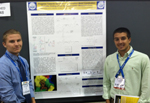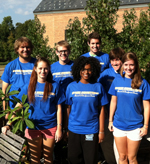Craig Streu
The honor of membership into Sigma Xi spans disciplines and courses of research study.
Each month in the Sigma Xi Today section of American Scientist magazine, and also on our website, we will be highlighting a different "Fellow Companion"—asking them about their work and what the honor of induction into Sigma Xi has meant for their career.
Dr. Craig Streu is an assistant professor of biochemistry at St. Mary's College of Maryland and the former recipient of a National Institute of Health fellowship in biophysics at the University of Pennsylvania Medical School. His interdisciplinary work in synthesizing compounds to study biomolecules has far-reaching implications in the search for cures for diseases ranging from HIV to cancer. His engaging perspective on the future of his field—and his outstanding advice for future researchers—is not to be missed.
biochemistry at St. Mary's College of Maryland and the former recipient of a National Institute of Health fellowship in biophysics at the University of Pennsylvania Medical School. His interdisciplinary work in synthesizing compounds to study biomolecules has far-reaching implications in the search for cures for diseases ranging from HIV to cancer. His engaging perspective on the future of his field—and his outstanding advice for future researchers—is not to be missed.
Tell us about your educational background including your doctoral research, if applicable.
In 2000 I graduated as valedictorian from Caro Community High School, a small public high school in the rural 'thumb' of Michigan. From there, I attended Albion College where I stumbled into the chemistry major after several years of research on chiral hypervalent iodine reagents in the lab of Professor Andrew French. After graduating summa cum laude in 2004, I attended graduate school in organic chemistry at the University of Pennsylvania where I worked with Professor Eric Meggers to develop catalyst/substrate systems for transition-metal catalysis in living cells. Midway through my graduate work, my focus changed to developing transition metal-based kinase inhibitors. After graduating with a Ph.D. in Chemistry from the University of Pennsylvania in 2009, I took an NIH fellowship in biophysics in the labs of Professors William DeGrado and Joel Bennett at the University of Pennsylvania Medical School. There, I studied the role of kindlin-3 in the inside-out activation of integrin •IIb•3 until I accepted my current position as an assistant professor of biochemistry at St. Mary’s College of Maryland in 2011.
Do you have a particular teacher or professor who inspired your love of science? Why?
A career in science was a complete accident. When visiting colleges I fell in love with Albion College, a small liberal arts college in Michigan. At first, attending this college seemed financially unthinkable. Unfortunately, Albion had offered me essentially every merit-based scholarship available and still, the price was more than that of the state college. Although there was no more merit-based aid on the horizon, the college was able to offer a paid internship in a research lab on campus. Although I considered myself a political science major, I figured I could do a little bit of research on the side if it meant I could go to the college of my choosing. As fate would have it, the organic chemistry lab of Professor Andrew French had an opening. I'm a scientist, chemist, and professor all because of that internship with Professor French.
What is the focus of your current research?
Currently, I work in a field known as chemical biology. Broadly speaking, chemical biologists are interested in developing chemical solutions to biological problems. As a chemical biologist, I have been able to work on many different systems including, opportunistic microbial infections, sweet proteins, lipid particles, redox proteins, and single stranded RNA. The projects are tied together through the chemical solutions that we employ to improve their study and/or modulate their function.
Tell us about something we might see in our daily lives that directly correlates to your work.
My work is easily applicable to daily life. Although only a fraction of one percent of lead compounds end up as FDA approved drugs, these compounds may still be useful. We have synthesized compounds that allow us to study a variety of biomolecules more closely. The biomolecules that we study have been implicated in everything from HIV to cancer. We are using our compounds to get a more complete picture of the molecular mechanisms of each of these diseases.
Although only a fraction of one percent of lead compounds end up as FDA approved drugs, these compounds may still be useful. We have synthesized compounds that allow us to study a variety of biomolecules more closely. The biomolecules that we study have been implicated in everything from HIV to cancer. We are using our compounds to get a more complete picture of the molecular mechanisms of each of these diseases.
Give us an example of how multi-disciplinary research directly contributed to your work.
As a chemical biologist, my work is by definition a multidisciplinary mix of techniques borrowed heavily from chemistry and biology. More specifically, my lab uses organic, inorganic, biochemical, biophysical, and molecular biology techniques to study the molecular mechanisms of disease. Still, despite the breadth of our research capabilities, science is by its very nature interdisciplinary and we have developed numerous collaborations with individuals outside our primary areas of expertise to more completely investigate a number of our research questions. In just the past year, my small research lab has collaborated with a microbiologist, a computational biologist, a medicinal chemist, an immunologist, and a chemical engineer. In each and every case, these experts contributed essential insights that have positively impacted the respective project.
What are your thoughts on the future of STEM education?
Although I myself am a purveyor of the liberal arts, there is no question that STEM education will be an increasingly important part of our future. Our planet faces a host of imminent environmental, resource, and energy crises. There is no question that science and technology, and by extension STEM education, will play a critical role in any potential solution to these impending situations. At the same time, to remain a leader in these fields, the United States must continue to invest in innovation and education in these areas.
Describe the patent/publishing experience—were there any bumps along the way for you?
The publishing experience can be both the most exciting and the most humbling part of scientific research. For me, the publication process got off to a rough start after my first submission was flatly rejected. While the experience was a bit demoralizing for a graduate student needing papers to graduate someday, this was my first sense of the broader impact of my work. For the first time, I was being asked questions about the usefulness and exhaustiveness of my work. Generally speaking, peer-reviewers have the best interest of science in mind. Hard knocks aside, learning to think as a reviewer early in my career has been one of the most positive lessons I've ever learned.
What has the honor of induction into Sigma Xi meant to you?
Sigma Xi is an excellent resource for professional development. It provides an arena for meeting like-minded individuals. Additionally, I am proud to be associated with an organization whose mission is the promotion of STEM fields and education.
What books are you currently reading for pleasure?
I'm an assistant professor, so right now reading for pleasure is confined to time spent keeping up on recent developments in my field. It's not the Da Vinci Code, but it beats reading student lab reports!
When you're not working on your research, what do you do in your free time?
When I'm not researching, teaching, or writing grants, I like to hike with my dogs. It's good exercise and their enthusiasm is a bit contagious.
What is your favorite motto?
"If we knew what we were doing, we wouldn't call it research, would we?"—Einstein
What advice would you give a young researcher just starting out in your field?
I have two pieces of advice for any young researcher. The first is to be self-motivated. Research is hard work and the vast majority of scientific advances go unrecognized. As a result, you have to do the work because you enjoy it, not because you expect recognition for your brilliance and hard work. Additionally, any successful researcher must be doggedly determined. Grants and papers will get rejected, experiments will fail—sometimes epically, and research directions will change. Your ability to learn from these experiences is a key predictor of long-term success as a scientist.
researcher. The first is to be self-motivated. Research is hard work and the vast majority of scientific advances go unrecognized. As a result, you have to do the work because you enjoy it, not because you expect recognition for your brilliance and hard work. Additionally, any successful researcher must be doggedly determined. Grants and papers will get rejected, experiments will fail—sometimes epically, and research directions will change. Your ability to learn from these experiences is a key predictor of long-term success as a scientist.